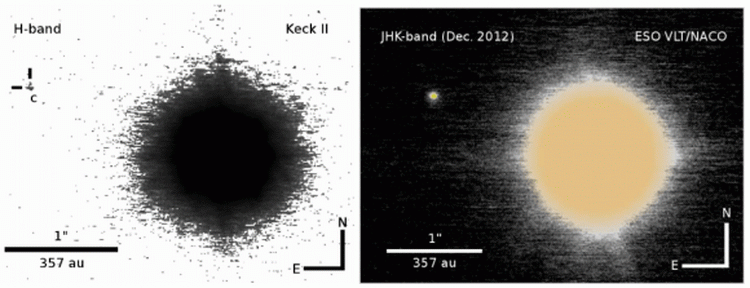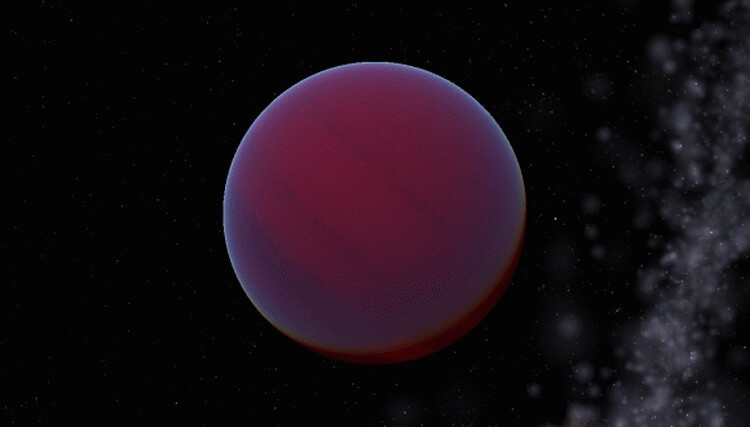- Get link
- X
- Other Apps

Each planet of our solar system has a significantly different orbital period of rotation around the Sun. For example, if the Earth has one revolution around the star occupying 365.25 days, then this takes about twice as much time for the same Mars - 686.97 days. In Jupiter and other gas giants of the system, the orbital period differs even more, ranging from 11.86 years to 164.8 years. But even with this in mind, astronomers were not quite ready for the fact that there are also such systems as, for example, CVSO 30.
In this star system, located about 1200 light-years from Earth, astronomers have discovered two candidates for exoplanets. If both objects are found, the mass of each of which is several times larger than the mass of Jupiter, an international group of astronomers used a transit as well as a direct method of observation. The researchers found that while the orbital period of one planet is less than 11 days, another planet makes a complete revolution around its star only once in 27,000 (twenty-seven thousand) years!
Interesting this discovery, of course, is not only because it could surprise scientists, but also because when detecting planets within one system, several different methods of searching were used at once.
To date, most of the more than 2000 detected exoplanets have been found by indirect observation methods. This is primarily about the so-called transit method of observation, which makes it possible to determine the presence of the planet by observing the change in brightness of the star, which occurs as a result of the planet's passage in front of its star, as well as by measuring the angular velocity, which makes it possible to detect the planet by revealing the gravitational effects that it exerts on the star.
So, one of the planets of this system - CVSO 30b - a mass of 5-6 times the mass of Jupiter was discovered by astronomers in 2012 using a transit method of observation. Scientists have found out that the planet is located at a distance of 1.2 million kilometers from the star (for comparison: the same Mercury is located 58 million kilometers from the Sun). Researchers describe the planet as "hot Jupiter".
The method of direct observation, in turn, is used by astronomers much less often. To date, with the help of it, only a few exoplanets have been discovered. The reason for this is that the light reflected from the atmosphere of the planet, as a rule, is not bright enough and merges against the background of the light of its native star, which makes observation difficult. In addition, this method is very demanding for the use of very high-quality and high-precision equipment. Nevertheless, compared to indirect search methods, it can be more effective when it comes to observing objects located in more remote regions of its stellar systems.
Thanks to the joint effort of the international team of astronomers using the Keck Observatory telescope on the island of Hawaii, the very large telescope of the European Southern Observatory in Chile, as well as the power of the Spanish observatory Calar Alto, discovered the planet CVSO 30c, located at a distance of about 666 astronomical units from its star .
Details about this discovery are published in the online library Arxiv.org. In this article, scientists representing such prestigious institutions as the Inter-American Observatory Cerro Tololo, the Jena Observatory, the European Space Agency, and the Max Planck Institute for Astronomy of Astronomy told about the methods they used to open the exoplanet and explained the importance of this discovery.

Observation of the star CVSO 30 by two different methods allowed finding a new candidate for exoplanets
"[Objects 30b and 30c] are very unusual in themselves. CVSO 30b is the first exoplanet discovered by the transit method, whose age is only about 2.5 million years. It was first described in 2012. All the other planets discovered in the same way were much older. A few hundred million years. It turned out to be a real surprise for us that she has a planetary neighbor that is at least 662 astronomical units from the star, which is approximately equal to 662 distances from Earth to the Sun, and at the same time possessing a mass of just 0.4 from the solar one. According to the standard model, planets are formed from the disk surrounding the star. However, we have never seen a large enough disk near such a small mass for the formation of such an object, "explains the project manager and the employee of the University of Hamburg, as well as the Jena Observatory Tobias Schmidt.
In other words, this means that astronomers did not expect to find two exoplanets with mass several times the mass of Jupiter, wrapped around such a small star as CVSO 30. However, the discovery of two exoplanets with such a difference in the distance between them and their star turned out to be for scientists even more surprising.
Using an extremely high-contrast photometric and spectroscopic observational data with the help of the Very Large Telescope, the Keck Telescope and the Kalar Alto Observatory, an international team of researchers was able to detect the CVSO 30c planet using the so-called Lucky Imaging system. The system automatically selects only those frames of the same section of the sky that were obtained at such rare happy moments, when the distortions from the atmosphere were minimal.

Brown dwarf of the spectral class T in the artist's view
As a result, scientists found an exoplanet with a very wide orbit and a mass 4-5 times larger than Jupiter. In fact, it turned out that the planet is also very young. Its age is less than 10 million years. Moreover, the spectroscopic data indicated its very unusual blue color, while the majority of the remaining candidates in the exoplanets, as a rule, were represented in the red spectral range.
Scientists note that CVSO 30c is the youngest planet of this class, which also managed to be detected directly. A further CVSO 30c study showed that it is most likely the first discovered "LT-class transit facility" that is less than 10 million years old. Usually, brown dwarfs are referred to the transit objects of the LT-class - the objects are too large to be considered as a planet, and at the same time too small for them to be considered as stars. As a rule, they are surrounded by massive clouds of gas and dust or completely devoid of any environment.
The researchers suggest that the CVSO 30c exoplanet, which is paired with the planet CVSO 30b (which is incredibly close to the star of the same system), most likely initially formed in another place, and then eventually departed substantially from its star. At least other guesses, the models of the planetary formation that we have, unfortunately, do not give. However, Professor Schmidt notes that this assumption at least tries to explain the definitely strange nature of these exoplanets.
The importance of discovery is also related to the fact that this is the first time when two methods of observation - transit and direct - were used to search for planets within one system. And in this case both methods proved to be useful.
"The transit method and the method of measuring the radial velocities have disadvantages. For example, it is not possible to find planets near young stars, since the increased activity of young stars creates problems in observations. CVSO 30b was the very first and the youngest planet discovered by these methods. The method of direct observation, in turn, is best suited for the search and exploration of young planets, since they are just completing the process of their final formation and, therefore, provide enough of their own light for observation. We were very fortunate that apart from an outer planet very far from our star, we managed to find a planet that is very close to its star in the same system. "
"The real benefit of the simultaneous use of the transit method and the method of direct observation is that the observations in this case become more detailed. We hope to learn more about the nature of its formation and in particular to find out how such systems are generally formed, "concludes Schmidt.
The article is based on materials .
- Get link
- X
- Other Apps
Comments
Post a Comment